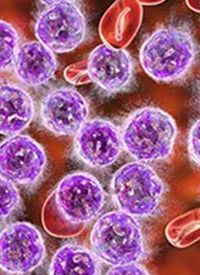John Theurer Cancer Center Investigators Confirm that Preserved Stem Cells Are Safe and Effective for Multiple Myeloma Treatment Up to 20 Years Later
Investigators from Hackensack University Medical Center’s John Theurer Cancer Center confirm that cryopreserved stem cells collected before a first stem cell transplant to treat multiple myeloma are just as viable and potent for use in a second "salvage" transplant 20 years later.

Investigators from Hackensack University Medical Center’s John Theurer Cancer Center confirmed that cryopreserved stem cells collected before a first stem cell transplant to treat multiple myeloma are just as viable and potent for use in a second "salvage" transplant up to 20 years later when a patient experiences a relapse of the disease. The study, published in the Journal of Transplantation and Cellular Therapy, is the first to compare outcomes of initial and salvage transplants in the same patients.
Multiple myeloma is a cancer of the bone marrow, and autologous stem cell transplantation—the collection of a patient's own stem cells from their bloodstream before chemotherapy, which are given back after chemotherapy to rebuild the blood-forming system—is a commonly used treatment. Multiple myeloma often comes back despite initial treatment, but it may not be for several years. For this reason, treatment guidelines recommend that enough stem cells are collected before the first transplant to support two transplants. The cells are frozen and stored in a vapor-phase liquid nitrogen refrigerator for storage below -150°C.
The study investigators assessed outcomes in 89 patients who received an initial stem cell transplant for multiple myeloma as well as a salvage transplant for relapsed disease at John Theurer Cancer Center between 2000 and 2021. The median period of time between the initial collection of the cells and the salvage transplant was 5.4 years, with some patients not receiving the second transplant until up to 19.7 years later. The researchers found that the amount of time it took for patients' bodies to rebuild their levels of neutrophils (white blood cells) and platelets (blood-clotting cells) was not significantly different between the first and salvage transplants.
"This study shows, for the first time in the same group of patients from a single institution, that it is safe to store stem cells for a very prolonged period of time while maintaining their viability and potency," explained Ronit Slotky, PhD, director of the Cell Therapies Manufacturing Facility at John Theurer Cancer Center and one of the study's lead authors. "You can infuse them into a patient with relapsed multiple myeloma up to 20 years later and they are still effective."
"Until now, data on stem cell transplantation outcomes after long-term storage have been limited. Our long and distinguished history of leadership in the field of bone marrow and stem cell transplantation and our high volumes of multiple myeloma patients have enabled us to report the first study demonstrating these outcomes in the same group of patients," said André Goy, MD, MS, chairman and executive director of John Theurer Cancer Center. "We are very proud to give patients with multiple myeloma and their providers confidence in the effectiveness of this approach."
“This publication was the result of the hard work and dedication of Dr. Slotky and her team,” said Scott Rowley, MD, FACP, Member, Stem Cell Transplantation and Cellular Therapy Program and medical director, Cell Therapies Manufacturing Facility, John Theurer Cancer Center. “This manuscript is a great accomplishment for our department and we are very proud to receive this recognition by the publisher.”
“This research is immediately beneficial to patients in our network, and also those across the world,” said Ihor Sawczuk, M.D., FACS, the chief research officer and president of Hackensack Meridian Health’s Northern Region. “This kind of dedicated, thorough science saves and improves lives, and is an example of why we are always looking for ways to keep getting better.”



